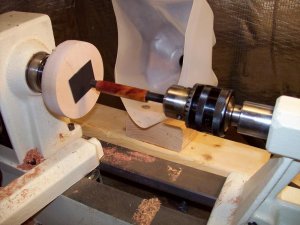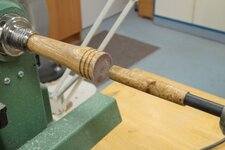mgatten
Member
I just started turning pens less than a week ago, but it has gone surprisingly well for a rank beginner.
I'm using CA for finish, and even that has gone great and has been much easier and less messy than I pictured.
But I do have one problem that I can't seem to find an answer for online:
As is common, the bearings tend to stick to the blank. So I use a razor to score the CA very, very close to the glue joint, and then snap them off. That works fine, without chipping the pen, but does tend to leave a tiny overhang of CA that I need to remove from each end of the blanks.
With the first pen, I figured it might just break off naturally during assembly. Instead, it caused chips at the end.
On the next pen, I ran it across some rough sandpaper. Which caused chips.
So then I tried fine sand paper. At first, I thought that worked, but once assembled I could see white rings on the ends of the parts.
Next, I tried buffing with micromesh, but it wouldn't remove the excess at all. I kept at it, and eventually seemed to make progress, but by then the CA had clouded.
So what am I missing? How do you get the end of the CA to be perfectly flush with the end of the barrel without risking chipping or clouding?
I'm using CA for finish, and even that has gone great and has been much easier and less messy than I pictured.
But I do have one problem that I can't seem to find an answer for online:
As is common, the bearings tend to stick to the blank. So I use a razor to score the CA very, very close to the glue joint, and then snap them off. That works fine, without chipping the pen, but does tend to leave a tiny overhang of CA that I need to remove from each end of the blanks.
With the first pen, I figured it might just break off naturally during assembly. Instead, it caused chips at the end.
On the next pen, I ran it across some rough sandpaper. Which caused chips.
So then I tried fine sand paper. At first, I thought that worked, but once assembled I could see white rings on the ends of the parts.
Next, I tried buffing with micromesh, but it wouldn't remove the excess at all. I kept at it, and eventually seemed to make progress, but by then the CA had clouded.
So what am I missing? How do you get the end of the CA to be perfectly flush with the end of the barrel without risking chipping or clouding?


